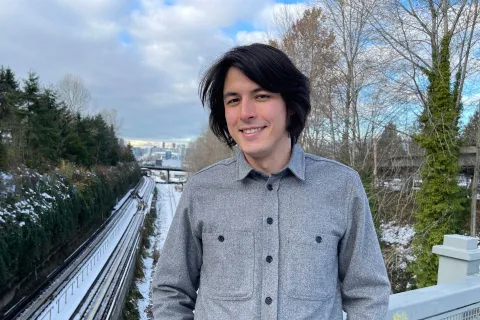"Seek out opportunities to reach across disciplines and forge new connections to respond creatively to the complex and entangled challenges of our time."

Brendan Buchanan Dee
- Degree: Master of Advanced Studies in Landscape Architecture
- Grad year: 2022
- Program:
- Campus: Vancouver
I was born and raised in Vancouver, BC. UBC’s School of Architecture and Landscape Architecture (SALA) has been my second home in recent years as I developed my capacities for design in the dual degree Master of Architecture and Master of Landscape Architecture (MARCLA) program followed by my recent focus on research in pursuit of my Master of Advanced Studies in Architecture (MASA). My passion for architecture and landscape architecture stems from my interest in the creative ways humans and non-humans have adapted to the unique environments and contexts which they inhabit. Prior to my time at UBC I received my Bachelor of Arts from McGill University with a major in Geography and minors in Geographic Information Systems and Political Science. During my undergraduate studies I spent a year at the University of Melbourne in Australia and during my graduate studies I went to Switzerland for a semester abroad at ETH Zurich. My multicultural upbringing and exposure to the diversity of people and places in Vancouver and beyond has instilled in me a deep appreciation for culture, history, art, and nature.
What has made your time at UBC memorable?
A major strength of UBC is its diversity as our school brings together people with countless perspectives and experiences. This is especially true in the architecture and landscape architecture programs where students from myriad academic, professional, and cultural backgrounds are brought together in studios and seminars where we learn to communicate with one another through design and graphic representation. I recall that in my introductory classes I had peers whose previous studies included engineering, music, photography, anthropology, and computer science among other fields, which contributed to lively discussions and unexpected design propositions.
Some of my most memorable experiences have been times spent in the studio, getting outside and conducting in-person site visits which provided a great reprieve from desk work and an opportunity to learn from direct observation and documentation. As designers of architecture and landscape architecture often seek change in the physical world, experiencing the existing conditions of sites has enormous potential to influence the direction of projects, informing the inventive ways we envision and embed our design proposals into the layered realities of the built environment. Throughout my studies I have had the privilege of visiting places in BC and internationally as part of my courses including Haida Gwaii, Kamloops, 100 Mile House, as well as Seattle, Spain and the Netherlands.
Where do you find inspiration for using your degree to make an impact on our world?
Throughout my time at UBC I’ve been surrounded by professors whose research and teaching have been a constant source of inspiration. Their passion has been contagious, seeding my aspirations for a career spanning design, research, and education. I’ve had the honor of working as a Graduate Research Assistant (GRA) on multiple occasions and I’m grateful for my time spent with elements Lab with Prof. Ron Kellett and Prof. Cynthia Girling, and for the opportunity to work on special topic research projects with Prof. Joe Dahmen and Prof. Fionn Byrne. I’m also thankful for the support of Prof. Adam Rysanek, Prof. Sara Stevens, and Prof. Blair Satterfield during the development of the MASA thesis. A special thank you to Prof. Rysanek who chaired my MARCLA graduate project and MASA thesis, and whose ongoing work with the Building Decisions Research Group is a model for interdisciplinary research and collaboration. I’m also deeply inspired by the students who I’ve had the privilege of working with as a Graduate Teaching Assistant (GTA) in support of LARC 316 with Prof. Douglas Justice and Prof. Karin England, ARCH 597D with Prof. Colette Parras, ARCH 597F with Prof. Tijana Vujosevic, DES 130 with Prof. Allison Earl, DES 220 with Prof. Roy Cloutier, and ARCH 548 with Prof. Matthew Soules. My family and friends have been highly encouraging, providing me with the love and support I need to make a positive impact through research and design.